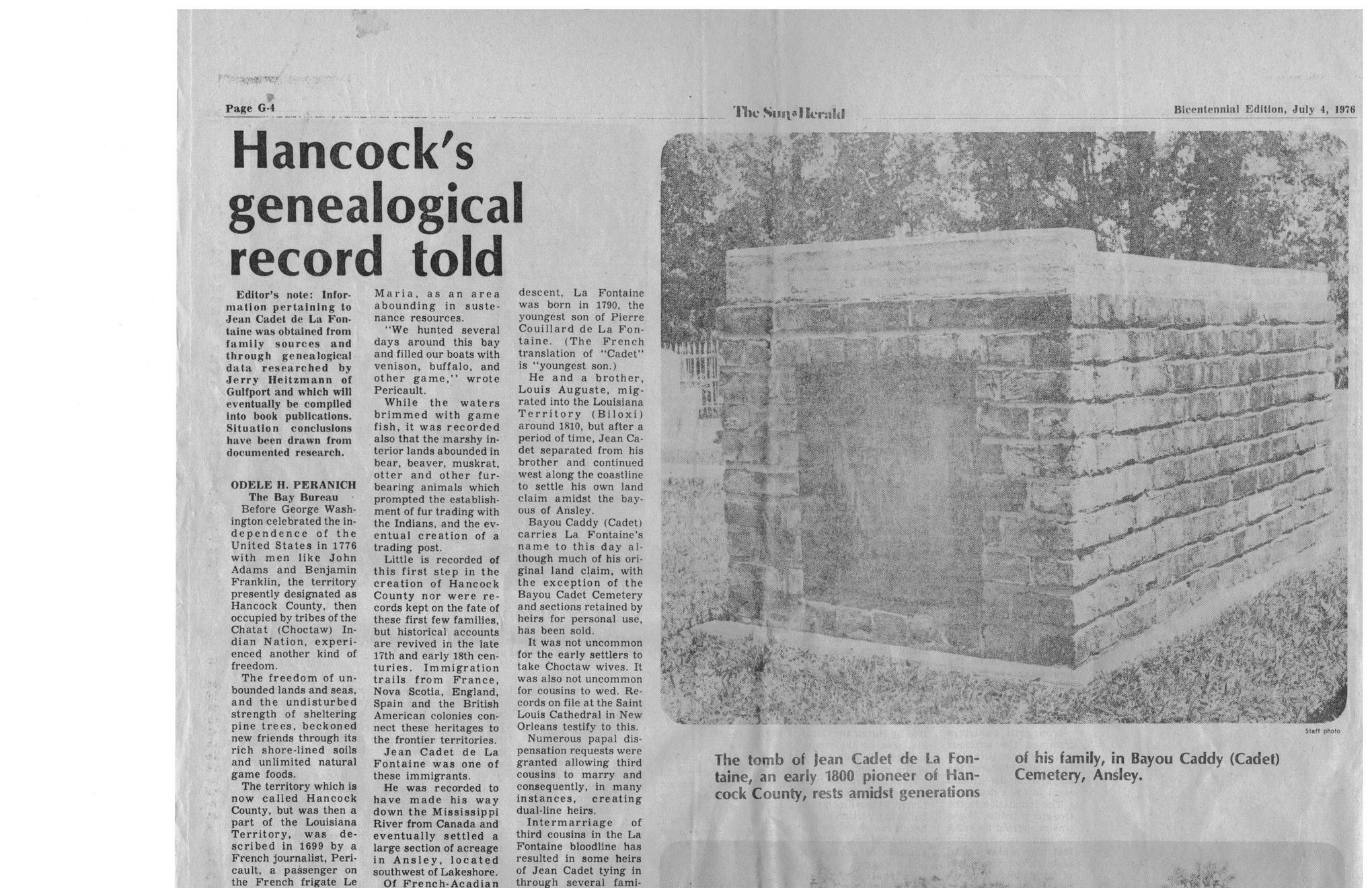This text was obtained via automated optical character recognition.
It has not been edited and may therefore contain several errors.
Page G-4
Hancock's genealogical record told
Editor’s note: Information pertaining to Jean Cadet de La Fontaine was obtained from family sources and through genealogical data researched by Jerry Heitzmann of Gulfport and which will eventually be compiled into book publications. Situation conclusions have been drawn from documented research.
ODELE H. PERANICH The Bay Bureau
Before George Washington celebrated the in-dependence of the United States in 1776 with men like John Adams and Benjamin Franklin, the territory presently designated as Hancock County, then occupied by tribes of the Chatat (Choctaw) Indian Nation, experienced another kind of freedom.
The freedom of unbounded lands and seas, and the undisturbed strength of sheltering pine trees, beckoned new friends through its rich shore-lined soils and unlimited natural game foods.
The territory which is now called Hancock County, but was then a part of the Louisiana Territory, was described in 1699 by a French journalist, Peri-cault, a passenger on the French frigate Le
Maria, as an area abounding in sustenance resources.
“We hunted several days around this bay and filled our boats with venison, buffalo, and other game,” wrote Pericault.
While the waters brimmed with game fish, it was recorded also that the marshy interior lands abounded in bear, beaver, muskrat, otter and other fur-bearing animals which prompted the establishment of fur trading with the Indians, and the eventual creation of a trading post.
Little is recorded of this first step in the creation of Hancock County nor were records kept on the fate of these first few families, but historical accounts are revived in the late 17th and early 18th centuries. Immigration trails from France, Nova Scotia, England, Spain and the British American colonies connect these heritages to the frontier territories.
Jean Cadet de La Fontaine was one of these immigrants.
He was recorded to have made his way down the Mississippi River from Canada and eventually settled a large section of acreage in Ansley, located southwest of Lakeshore.
Of French-Acadian
descent, La Fontaine was born in 1790, the youngest son of Pierre Couillard de La Fontaine. (The French translation of “Cadet" is “youngest son.)
He and a brother, Louis Auguste, migrated into the Louisiana Territory (Biloxi) around 1810, but after a period of time, Jean Cadet separated from his brother and continued west along the coastline to settle his own land claim amidst the bayous of Ansley.
Bayou Caddy (Cadet) carries La Fontaine’s name to this day although much of his original land claim, with the exception of the Bayou Cadet Cemetery and sections retained by heirs for personal use, has been sold.
It was not uncommon for the early settlers to take Choctaw wives. It was also not uncommon for cousins to wed. Records on file at the Saint Louis Cathedral in New Orleans testify to this.
Numerous papal dispensation requests were granted allowing third cousins to marry and consequently, in many instances, creating dual-line heirs.
Intermarriage of third cousins in the La Fontaine bloodline has resulted in some heirs of Jean Cadet tying in through several fami-
IllC SlU^IIcrafd _ Bi('pntenn,al Edition, July 4, 1976
Staff photo
The tomb of Jean Cadet de La Fon- of his family, in Bayou Caddy (Cadet)
taine, an early 1800 pioneer of Han- Cemetery, Ansley.
cock County, rests amidst generations

BSL 1970 To 1976 Newspaper-Clippings-BSL-'70-'76-(12)